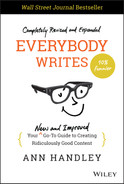51
The Six Elements of a Marketing Story
I'm tempted to insert something here about how stories stir our souls. They draw us in. Connect us in a shared experience. Shape our point of view.
But you are human. You know that already, right?
You've binge-watched a billion hours of Netflix. You know how compelling a story can be: how part of you is willing to rationalize maybe just one more episode … even as the rational part of you knows you need to sleep.
(“Go to bed! Tomorrow morning is going to be rough!” Rational-You says. Irrational-You counters: “But here comes the next episode! It's already buffering in! Maybe just 10 minutes…?”)
The best marketing has figured out the power of story, too.
Powerful storytelling stirs emotions. It can shape beliefs and change behaviors. It can help complex ideas or concepts become more accessible.
Storytelling helps make us memorable, because humans remember stories more than facts or figures or concepts.
And, of course, the explosion of marketing platforms and channels now offers us exponentially more ways to tell and share stories.
Which is why in the past few years we've seen a bounty of inspired brand storytelling. But we've also seen some terrible efforts. Because telling a true story well is about “as easy and pleasurable as bathing a cat,” as the writer Anne Lamott puts it.
So the challenge for us all: How do we bathe the cat?
How do we pull compelling stories out of our own organizations? How do we tell a brand story or a more specific product story in an interesting way that relates to our customers?
We've got this. Let's start by understanding the six characteristics of a compelling marketing story:
- It’s true. Make truth the cornerstone of any story you create. That means real people, real situations, genuine emotions, and actual facts. Write with integrity and accountability: Be honest with your readers.
As much as possible, your story should show, not tell. It should explain—in terms people can relate to—how your company or product adds value to the lives of customers.
“True” also means that you credit original sources. Ground your stories in data. Acknowledge any bias that may compromise your point of view. Link to sources generously. Cite reliably. Disclose all connections, sponsors, conflicts, or potential biases. And finally: Limit the number of anonymous sources. (There is more on all this in other sections of this book.)
- It’s human. Even if you are a company that sells to other companies, focus your story on how your products or services improve the lives of actual people. Or (better yet!) an actual person.
Again, a good rule to remember: Be specific enough to be believable, and universal enough to be relevant. (That's a nugget from my journalism school days.)
- It’s original. Offer a new, fresh perspective.
What's interesting about your company? Why is it important? Is it uniquely you?
Again: If you covered up your logo on your website or video or blog or social channels or any content you've produced … do you sound unique? Would people still recognize it as coming from you?
- It makes your customer the hero. Your product might be as revolutionary as an escalator to the moon. But your story isn't about that: It's not about what you do or what you sell; it's what you do for others.
How does your product help people? How does it shoulder their burdens? How does it ease their pain? Answer their questions?
How does your product live in the world?
Your customer is your hero—the protagonist or main character in your story. Put them smack at the center it.
Will your reader or viewer feel a flash of recognition in your story? Do they see themselves in it?
Brand stories that don't revolve around a customer-protagonist feel corporate-centric. They come across as indulgent (at best) or boring (at worst).
Focus on how your products or services touch people's lives—even if you sell something that some might consider inherently boring (like technology, toasters, or tongue depressors).
Paint a picture of why people should care about your tech.
Or toast.
Or depressed tongues.*
- It makes people feel something. Does your story ignite real emotion in hearts and minds?
And finally …
- It’s aligned with a long-term business strategy. The best stories grow out of your brand positioning (what you do and for whom) and your unique value proposition (what you offer better than or unlike others). They're developed and designed to fuel your marketing goals.
Said another way:
Your Brand Positioning
+
Your Unique Value
+
Your Marketing Goals
-----------------------------------------------------------------------------------------------------------------------------
Your True, Human-Sized, Original, Soul-Stirring Customer-As-Hero Stories
* * *
Did you notice that the goals piece came last in this list?
That's not because it's not important. It is. But it's last because a strategy-first story tends to be about as compelling as an instruction manual.
Start with people.
Infuse with emotion.
Align with strategy.
Note
- * Now picturing emotionally distressed tongues.
